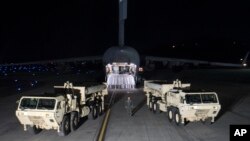On March 6, North Korea fired four ballistic missiles that flew about 1,000 kilometers, with three of them landing in Japan’s exclusive economic zone, according to South Korean and Japanese officials. This is the latest in a series of missile test-launches of various ranges in recent months.
In response to this ongoing threat from North Korea, the United States and South Korea committed in July 2016 to the deployment of Terminal High Altitude Area Defense, THAAD, to South Korea. United States Pacific Command, or PACOM, recently deployed the first elements of THAAD.
North Korea’s accelerating campaign of nuclear and ballistic missile tests threaten international peace and security and violate multiple United Nations Security Council resolutions, Pacom officials said, adding that the THAAD deployment contributes to a layered missile defense system thereby enhancing the alliance’s defense against North Korean missile threats.
"Continued provocative actions by North Korea, to include [the March 6th] launch of multiple missiles, only confirm the prudence of our alliance decision last year to deploy THAAD to South Korea," said Navy Admiral and Pacom commander Harry Harris. "We will resolutely honor our alliance commitments to South Korea and stand ready to defend ourselves, the American homeland, and our allies."
THAAD is a strictly defensive system, and poses no threat to other countries in the region, Pacom officials said. It is designed to intercept and destroy short- and medium-range ballistic missiles inside or outside the atmosphere during their final phase of flight.
Pacom joint military forces remain vigilant in the face of North Korean ballistic missile threats and provocations and are fully committed to working closely with South Korea to maintain security in the region.












